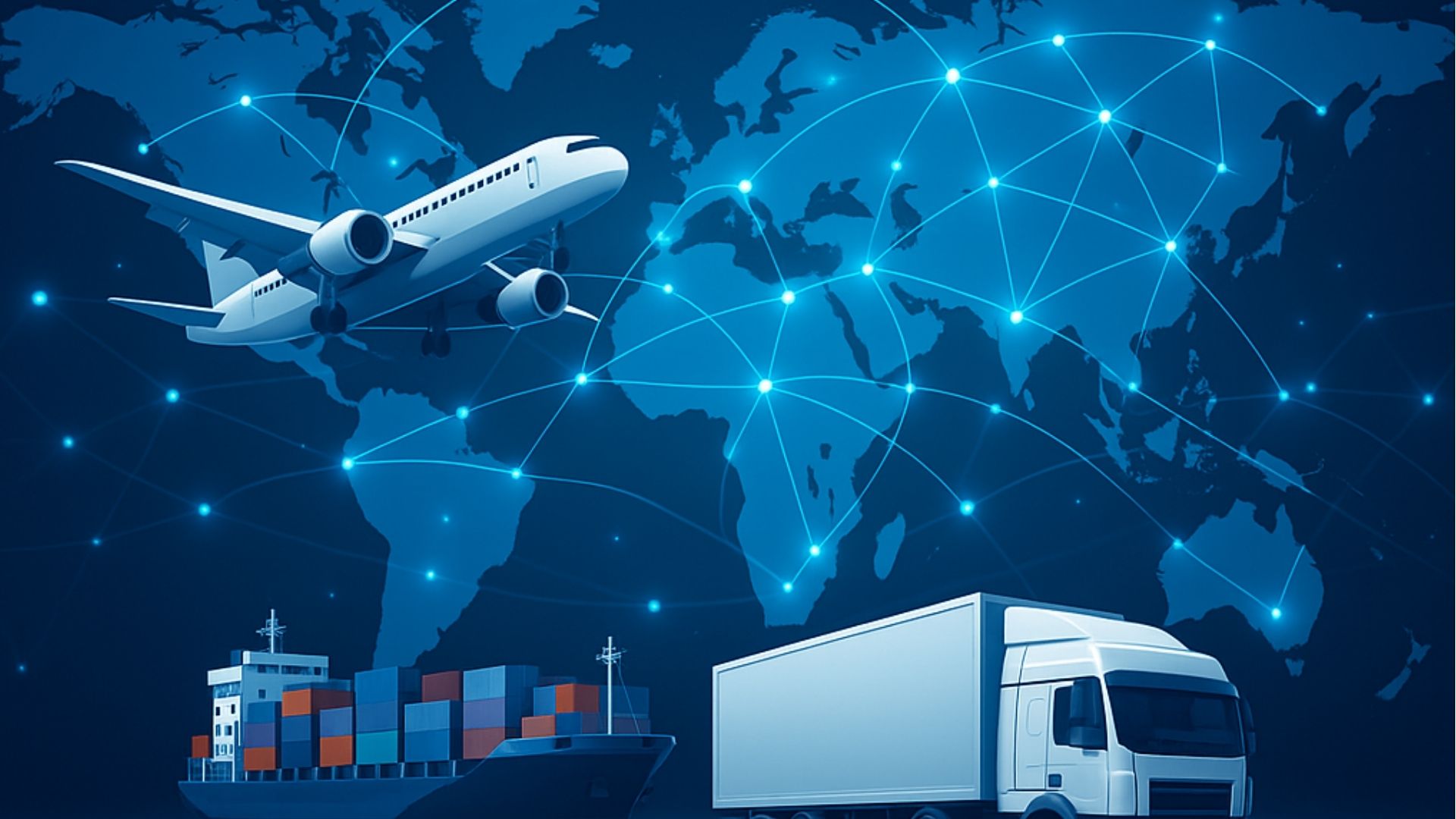Global Supply Chains Need Global Connectivity: How eSIM Bridges the Gap
Global supply chains thrive on data, speed, and coordination — but traditional connectivity models can’t keep up with international demands. eSIM technology revolutionizes logistics by delivering seamless global coverage, real-time visibility, and centralized device control. As industries evolve toward automation and AI-driven operations, eSIM bridges the gap between digital intelligence and physical movement, enabling true end-to-end global connectivity.

In today’s hyper-connected world, the efficiency of a global supply chain depends not only on logistics, partners, and infrastructure — but on connectivity. Supply chains are the backbone of international commerce, powering industries from manufacturing to retail. Yet, in a digital era where real-time visibility and control are critical, traditional connectivity models can’t keep pace.
Enter eSIM technology, a breakthrough that’s transforming how global enterprises monitor, manage, and optimize their logistics operations. By enabling seamless, programmable connectivity across regions and carriers, eSIM bridges the gap between global movement and global data — empowering businesses with real-time control, lower operational costs, and enhanced resilience.
This blog explores how eSIM strengthens global supply chains, addressing the pain points of fragmentation, compliance, and inefficiency while unlocking a new age of intelligent logistics and connectivity.
Why Global Supply Chains Struggle with Connectivity
The supply chain has always been complex — a web of manufacturers, transporters, distributors, and retailers spanning multiple countries and networks. However, the shift to data-driven logistics has introduced a new challenge: continuous and reliable global connectivity.
Let’s break down the most common challenges that multinational logistics and supply networks face today:
1. Fragmented Networks
Traditional SIM-based systems depend on carrier-specific contracts and local coverage zones. When goods cross borders, devices often lose connectivity or require manual reconfiguration, leading to data blackouts during transit.
2. Lack of Real-Time Visibility
Without reliable IoT and M2M (machine-to-machine) connections, it’s nearly impossible to monitor shipments in real-time. Lost visibility translates to delayed responses, inaccurate ETAs, and higher risk of theft or spoilage — especially in sensitive sectors like pharmaceuticals or perishables.
3. High Roaming Costs
International roaming costs for connected devices can quickly accumulate, especially when logistics equipment (like GPS trackers or IoT-enabled pallets) moves through multiple regions daily.
4. Complex Management
Managing thousands of SIM cards across fleets, containers, and hubs can be administratively burdensome. From activation and provisioning to carrier negotiation, the traditional model lacks scalability.
5. Compliance and Data Sovereignty
Different countries have unique regulations governing data use and localization. Maintaining compliance while ensuring cross-border connectivity adds another layer of difficulty.
These challenges underscore one fact: modern supply chains can’t rely on outdated connectivity frameworks. To achieve the agility that global markets demand, businesses need a universal, flexible, and secure connectivity solution — and that’s exactly what eSIM delivers.
What is eSIM and Why It Matters for Supply Chains
An eSIM (embedded SIM) is a programmable SIM chip embedded within a device. Unlike traditional physical SIM cards, eSIMs allow users to switch between carriers and profiles remotely, without needing to physically replace the SIM.
For global supply chains, this flexibility is a game-changer.
Here’s how eSIM transforms logistics and operations:
- Remote provisioning: Update carrier profiles and activate data plans over-the-air.
- Global coverage: Partner with multiple carriers through a single platform.
- Reduced downtime: Maintain connectivity even when crossing borders.
- Centralized management: Control thousands of connected devices through one dashboard.
- Improved cost efficiency: Avoid roaming charges with localized profiles.
Whether it’s tracking containers across oceans, monitoring cold chain temperatures, or coordinating fleets across regions, eSIM ensures that devices remain connected — always.

Connect Every Mile of Your Supply Chain
Ensure uninterrupted logistics visibility and smarter operations with global eSIM connectivity.
How eSIM Bridges the Connectivity Gap in Global Supply Chains
Let’s explore how eSIM addresses the most pressing pain points in modern logistics:
1. Seamless Cross-Border Connectivity
When containers move across borders, traditional SIM cards often fail due to roaming restrictions or network incompatibility. eSIM technology eliminates that barrier by allowing logistics devices to automatically switch to the best available local carrier.
This means uninterrupted IoT data flow — whether a shipment moves from Shanghai to Rotterdam or from Los Angeles to Mexico City.
2. Unified Device Management
Global supply chains deploy thousands of connected sensors, GPS trackers, and vehicles. Managing each device manually is inefficient. eSIM centralizes this process. Through a single management platform, companies can monitor connectivity status, activate or suspend profiles, and push updates remotely.
For multinational logistics providers, this reduces administrative overhead and enhances operational visibility.
3. Real-Time Data Access for Smarter Decisions
Supply chain disruptions — from weather delays to border congestion — can be mitigated through timely insights. eSIM ensures that devices transmit data consistently, enabling real-time analytics and predictive decision-making.
Companies gain actionable insights such as:
- Live route optimization
- Temperature and humidity monitoring
- ETA predictions
- Inventory level alerts
- Equipment maintenance schedules
4. Cost Optimization
By replacing roaming-heavy traditional SIMs with local carrier profiles dynamically provisioned via eSIM, companies can significantly reduce costs. Additionally, eSIM allows enterprises to negotiate better wholesale rates directly with multiple network partners, without being locked into a single carrier.
5. Enhanced Resilience and Redundancy
Supply chains rely on continuity. When a network goes down or coverage becomes unstable, eSIM’s multi-carrier flexibility ensures automatic fallback to the next best provider. This redundancy strengthens operational resilience — especially in remote or unpredictable environments.
6. Compliance Across Borders
Data sovereignty laws require that certain data stay within local jurisdictions. eSIM platforms can help organizations maintain compliance by dynamically switching to regional network profiles that adhere to local data routing requirements.
In sectors like healthcare logistics or defense supply, this flexibility is crucial.
Sector-Specific Impacts: eSIM in Action
1. Manufacturing
Factories with global supplier bases depend on connected IoT devices for predictive maintenance and production optimization. eSIM ensures that smart sensors remain connected even as assets move between factories or through international supply corridors.
2. Shipping and Freight
For maritime operations, eSIM helps overcome one of the hardest connectivity challenges — global oceanic routes. Ships and cargo containers equipped with eSIM-enabled devices can connect to satellite and coastal networks seamlessly, ensuring end-to-end visibility.
3. Cold Chain Logistics
For temperature-sensitive goods like pharmaceuticals or food products, real-time monitoring is essential. eSIM connectivity ensures uninterrupted sensor transmission, even when moving across network zones, minimizing the risk of spoilage or loss.
4. Automotive and Fleet Management
Fleet operators rely on telematics, route tracking, and performance data. With eSIM, they can manage vehicles across countries without manual SIM swaps, ensuring operational consistency and real-time updates across borders.
5. Retail and Last-Mile Delivery
In e-commerce, delivery speed and transparency define customer satisfaction. eSIM-equipped tracking devices and scanners keep warehouses, vehicles, and delivery points interconnected for seamless logistics execution.
eSIM and IoT: The Backbone of the Connected Supply Chain
The Internet of Things (IoT) has become integral to supply chain digitization. Billions of sensors now monitor goods, vehicles, and facilities worldwide. But IoT’s potential can only be fully realized when devices stay connected continuously — and globally.
That’s where eSIM creates synergy.
Key Benefits of eSIM-Enabled IoT in Supply Chains:
- Continuous global coverage: Devices automatically connect to local networks.
- Scalable deployments: Activate new sensors remotely without physical intervention.
- Predictive analytics: Reliable data streams feed machine learning systems for forecasting.
- Sustainability: Optimize energy use, routes, and asset utilization to reduce carbon footprint.
By powering IoT with eSIM, companies can eliminate connectivity silos and achieve unified, data-rich operations — the hallmark of the modern digital supply chain.
The Strategic Advantages of eSIM Adoption
1. Business Agility
The pandemic and geopolitical tensions have shown how quickly supply chains can be disrupted. eSIM gives enterprises the flexibility to reconfigure operations, reroute shipments, or activate new partners instantly — without waiting for new SIM cards or carrier contracts.
2. Simplified Global Expansion
Companies expanding into new markets no longer need separate carrier relationships for each region. With eSIM, they can scale operations across continents under one connectivity framework.
3. Future-Ready Infrastructure
As 5G and private network adoption accelerates, eSIM ensures that enterprise devices are ready for next-gen connectivity standards, future-proofing investments.
4. Sustainability and Operational Efficiency
eSIM reduces the need for physical card manufacturing, shipping, and manual replacement, aligning with ESG (Environmental, Social, Governance) goals. Additionally, its ability to optimize routing and resource allocation supports greener supply chain practices.

Control Your Fleet with a Single Dashboard
Simplify global operations — manage thousands of IoT devices through one secure eSIM platform.
The Technology Behind eSIM: How It Works
eSIM technology follows the GSMA’s Remote SIM Provisioning (RSP) architecture. This enables carriers and enterprises to securely download, manage, and switch network profiles over the air.
Here’s a simplified breakdown of how eSIM works in a logistics context:
- Profile Creation: A carrier or enterprise creates a digital SIM profile.
- Remote Download: The profile is securely downloaded to the eSIM chip.
- Activation: The profile becomes active, granting network access.
- Switching: If a better carrier becomes available, the eSIM can switch automatically or manually.
- Centralized Management: Enterprises can oversee thousands of profiles from a single interface.
This flexibility makes eSIM not only more efficient but also more secure — thanks to encryption and built-in authentication protocols.
Security Considerations in Global eSIM Deployments
As data flows across global networks, security remains paramount. Fortunately, eSIM technology comes with advanced safeguards that exceed traditional SIM capabilities.
1. Encrypted Communication
eSIM provisioning and profile management are secured using end-to-end encryption, preventing unauthorized interception.
2. Authentication and Identity Protection
Each eSIM is uniquely identified and authenticated through secure keys, ensuring that only approved devices connect to enterprise systems.
3. Remote Deactivation
If a device is lost or compromised, enterprises can instantly deactivate its eSIM profile, preventing misuse.
4. Compliance Alignment
Because eSIM can localize data routing, it helps enterprises comply with GDPR, HIPAA, and regional telecom regulations — a major advantage for global logistics operations.
Adoption Challenges and How Enterprises Overcome Them
Despite its advantages, eSIM adoption requires careful planning and infrastructure adaptation. Common challenges include:
- Integration with legacy systems — requiring IoT platform upgrades or middleware.
- Carrier collaboration — ensuring compatibility with global MNOs and MVNOs.
- Staff training — helping operational teams understand new provisioning models.
Leading enterprises overcome these hurdles by partnering with specialized global connectivity providers who deliver turnkey eSIM management solutions with APIs, dashboards, and analytics tools tailored to logistics environments.
The Future of eSIM in Global Logistics
As industries move toward Industry 4.0, autonomous supply chains, and AI-driven optimization, eSIM is emerging as the silent enabler behind the transformation.
Trends shaping the next decade include:
- 5G + eSIM convergence for ultra-low latency communications.
- Private LTE networks leveraging eSIM for controlled enterprise connectivity.
- Blockchain-based supply tracking with eSIM-enabled authenticity verification.
- AI-driven logistics automation powered by uninterrupted data flow.
By 2030, analysts predict that over 70% of logistics IoT devices will use eSIM technology, solidifying its role as the digital nervous system of global supply operations.
Why Global Connectivity Partners Matter
To maximize the value of eSIM, companies should collaborate with partners offering:
- Multi-carrier global coverage
- Centralized eSIM management platforms
- Flexible, usage-based pricing
- Regulatory and data compliance expertise
- APIs for integration with logistics systems
These partnerships turn connectivity from a cost center into a competitive advantage.

Future-Proof Your Logistics Infrastructure
Adopt scalable, secure, and sustainable eSIM connectivity for global growth.
Conclusion: Bridging the Global Gap
In the world of global trade, logistics speed, accuracy, and adaptability define success. Connectivity is no longer an afterthought — it’s the foundation of operational excellence.
eSIM technology bridges the connectivity gap that has long divided regional operations, empowering businesses to unify data, optimize performance, and maintain resilience no matter where they operate.
As supply chains become smarter and more autonomous, eSIM stands as the invisible force enabling seamless communication between people, machines, and markets — the true bridge between global logistics and global intelligence.



 10 min read
10 min read





